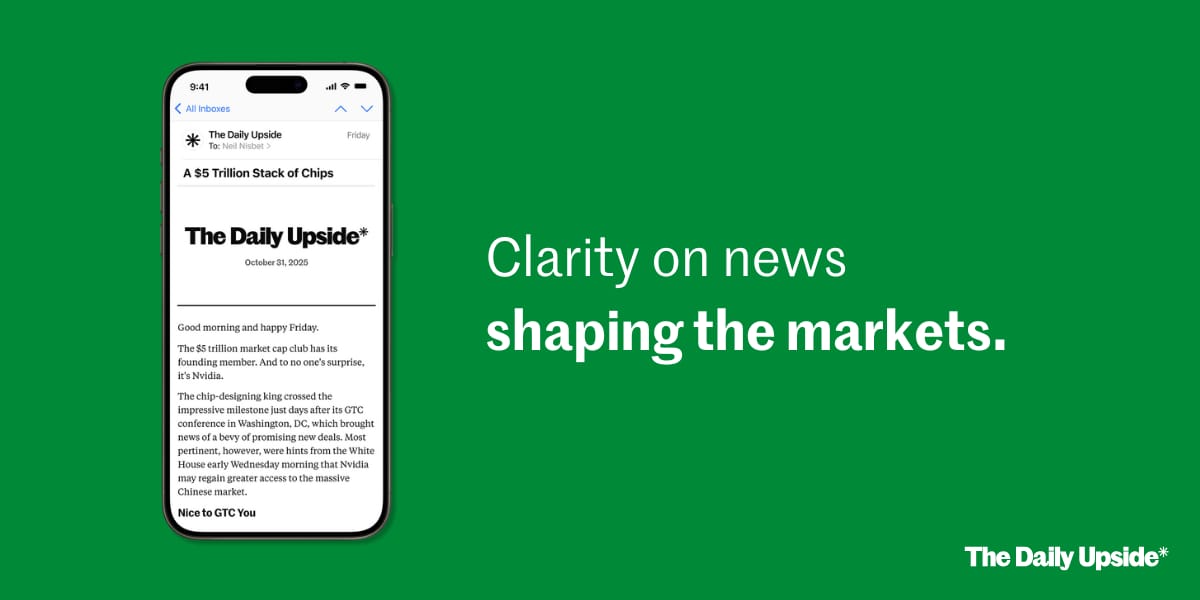Stop Drowning in Market News. Focus On Making Money.
Every day: 847 financial headlines, 2,300 Reddit stock mentions, 156 Twitter trading threads, 12 IPO updates, 94 crypto developments.
Your problem isn't lack of information; you have too much.
While you're scanning headlines wondering what matters, profitable trades slip by. The signal gets buried in noise.
What if someone did the heavy lifting for you?
Stocks & Income reads everything:
Twitter traders
Reddit buzz
IPO announcements
Crypto insider takes
Crowdfunding opportunities
Market news
Then we send you only what can actually move your portfolio.
No fluff. No useless news. Just actionable stock insights in 5 minutes.
We track every source so you don't have to. You get the 3-5 opportunities worth your time, delivered daily.
Stop wasting time on useless “investing news” and start thinking critically about real opportunities in the stock market.
Stocks & Income is for informational purposes only and is not intended to be used as investment advice. Do your own research.
Exciting News: Paid Subscriptions Have Launched! 🚀
On September 1, we officially rolled out our new paid subscription plans at GuruFinance Insights, offering you the chance to take your investing journey to the next level! Whether you're just starting or are a seasoned trader, these plans are packed with exclusive trading strategies, in-depth research paper analysis, ad-free content, monthly AMA sessions, coding tutorials for automating trading strategies, and much more.
Our three tailored plans—Starter Investor, Pro Trader, and Elite Investor—provide a range of valuable tools and personalized support to suit different needs and goals. Don’t miss this opportunity to get real-time trade alerts, access to masterclasses, one-on-one strategy consultations, and be part of our private community group. Click here to explore the plans and see how becoming a premium member can elevate your investment strategy!
I tested the “Double 7” strategy popularised by Larry Connors in the book “Short Term Trading Strategies That Work”. It’s a pretty simple strategy with very few rules.
Setup steps are:
Entry conditions:
Price closes above 200 day moving average
Price closes at a 7 day low
If the conditions are met, the strategy enters on the close. However for my backtest, I am entering at the open of the next day.
Exit if the price closes at a 7 day high
Run ads IRL with AdQuick
With AdQuick, you can now easily plan, deploy and measure campaigns just as easily as digital ads, making them a no-brainer to add to your team’s toolbox.
You can learn more at www.AdQuick.com
Backtest
To test this out I ran a backtest in python over 34 years of S&P500 data, from 1990 to 2024. The equity curve is quite smooth and steadily increases over the duration of the backtest.

Negatives
To check for robustness, I tested a range of different look back periods from 2 to 10 and found that the annual return is relatively consistent but the drawdown varies a lot.
I believe this was because it doesn’t have a stop loss and when I tested it with 8 day periods instead of 7 days for entry and exit, it had a similar return but the drawdown was 2.5x as big. So it can get stuck in a losing trade for too long.
Variations
To overcome this, I tested a few different exit strategies to see how they affect the results:
Add stop loss to exit trade if close is below 200 MA — This performed poorly compared to the original strategy
Exit at the end of the same day — This also performed poorly
Close above 5 day MA — This performed well and what’s more, it was consistent across different lookback periods, unlike the original strategy rules.
Trailing stop — This was also good and performed similarly to the 5 MA close above.
Check Out Our Premium Content Articles
Based on the above. I selected the “close above 5 day MA” as my exit strategy and this is the equity chart:

Wall Street’s Morning Edge.
Investing isn’t about chasing headlines — it’s about clarity. In a world of hype and hot takes, The Daily Upside delivers real value: sharp, trustworthy insights on markets, business, and the economy, written by former bankers and seasoned financial journalists.
That’s why over 1 million investors — from Wall Street pros to Main Street portfolio managers — start their day with The Daily Upside.
Invest better. Read The Daily Upside.
Results
I used the modified strategy with the 5 MA close for the exit, while keeping the entry rules standard and this is the result compared to buy and hold. The annualised return wasn’t as good as buy and hold, but the time in the market was only ~18% so it’s understandable that it can’t generate as much. The drawdown was also pretty good.
It also has a decent winrate (74%) and relatively good R:R of 0.66.

Conclusion:
It’s an interesting strategy, which should be quite easy to trade/automate and even though the book was published many years ago, it seems to continue producing good results. It doesn’t take a lot of trades though and as a result the annualised return isn’t great and doesn’t even beat buy and hold. But used in a basket of strategies, it may have potential. I didn’t test on lower time frames, but that could be another way of generating more trading opportunities.
Caveats:
There are some things I didn’t consider with my backtest:
The test was done on the S&P 500 index, which can’t be traded directly. There are many ways to trade it (ETF, Futures, CFD, etc.) each with their own pros/cons, therefore I did the test on the underlying index.
Trading fees — these will vary depending on how the trader chooses to trade the S&P500 index (as mentioned in point 1). So i didn’t model these and it’s up to each trader to account for their own expected fees.
Tax implications — These vary from country to country. Not considered in the backtest.
Code
The code for this backtest can be found on this github: https://github.com/russs123/double7







